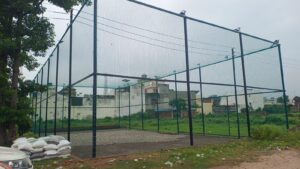Cricket is more than just a sport in India—it’s an emotion, a unifying passion, and a booming career opportunity for many aspiring players. As cricket continues to grow at both grassroots and professional levels, many schools, academies, and private investors are keen to build cricket grounds.
A common question that arises is: “Is 1 acre enough for a cricket ground?”
At A.S Sports And Infra, we specialize in sports infrastructure and turf installation, and we often receive this query from clients who want to develop cricket facilities. In this blog, we will break down the space requirements, possibilities, and alternatives for building a cricket ground on 1 acre of land.
1. Understanding Cricket Ground Dimensions
Before we decide whether 1 acre is enough, it’s important to understand the standard dimensions of a cricket ground.
-
- International Cricket Council (ICC) Guidelines:
-
- Minimum boundary distance from the center: 65 meters (213 feet)
-
- Maximum boundary distance from the center: 90 meters (295 feet)
-
- This makes the diameter of a full-size ground between 130m to 180m.
-
- International Cricket Council (ICC) Guidelines:
-
- Area Calculation:
-
- A professional cricket ground with 65m radius requires about 13,273 m² (3.3 acres).
-
- A ground with 90m radius requires about 25,446 m² (6.3 acres).
-
- Area Calculation:

2. What Can You Build on 1 Acre?
While 1 acre is not sufficient for an international-standard cricket ground, it is still very useful for smaller cricket facilities. Depending on your vision, you can develop:
a) Mini Cricket Grounds / Practice Grounds
On 1 acre, you can create a smaller cricket ground suitable for local matches, training sessions, or school tournaments. The boundaries will be shorter (30–45 meters), but it can still serve recreational and training purposes.
b) Box Cricket Arenas
Box cricket is becoming extremely popular in urban India. On 1 acre, you can build multiple box cricket turfs (enclosed, artificial turf-based smaller grounds) which are ideal for fast-paced 5–10 over matches. This model is also highly profitable for investors.
c) Cricket Nets and Practice Pitches
Another excellent use of 1 acre is to develop professional practice facilities:
-
- Multiple turf and cement wickets
-
- Artificial turf pitches
-
- Enclosed practice nets with floodlights
This is perfect for academies and schools that focus on player development.
- Enclosed practice nets with floodlights
d) Hybrid Sports Facility
Since cricket requires a lot of space, you can also use 1 acre to create a multi-sport turf that includes a smaller cricket ground along with football or tennis setups, ensuring maximum utility of the space.
3. Factors to Consider Before Developing on 1 Acre
At AS Sports And Infra, we guide our clients by analyzing these key points before installation:
i) Purpose of the Ground
-
- Professional Matches → Not feasible on 1 acre
-
- Training / Academy Use → Possible with smaller boundaries and pitches
-
- Commercial Box Cricket Arena → Ideal for 1 acre projects
ii) Type of Turf
-
- Natural Grass → Requires more space and heavy maintenance
-
- Artificial Turf → Best for smaller setups like box cricket or training grounds; durable, low maintenance, and all-weather playable
iii) Seating and Amenities
If you plan to add seating, pavilions, or changing rooms, you’ll need to plan accordingly as these will reduce the playing area.
iv) Budget and ROI
Developing a full-fledged ground on 1 acre may not be feasible, but a box cricket model or academy with practice pitches can generate excellent returns through coaching fees, tournaments, and rentals.
4. Box Cricket on 1 Acre – A Profitable Idea
In recent years, box cricket has transformed cricket in urban areas. It requires less space, fewer players, and offers exciting, fast-paced matches.
-
- Dimensions: A typical box cricket turf measures 120 ft × 60 ft.
-
- Capacity: On 1 acre, you can easily build 4–6 box cricket turfs.
-
- Revenue Model: Players book slots by the hour, making it highly profitable for investors.
At A.S Sports And Infra, we have successfully developed several box cricket arenas across India, which are now thriving sports and business hubs.
5. Academy Model on 1 Acre
If the purpose is not revenue but player development, 1 acre is sufficient for:
-
- 4–6 cricket practice nets
-
- 2–3 turf/cement pitches
-
- A small outfield for drills and matches
This model is popular among schools and training academies. Many academies in India operate on less than an acre of land, producing quality cricketers through focused training facilities.
6. Creative Alternatives for 1 Acre Projects
If you are limited to 1 acre, here are a few creative solutions:
-
- Develop multi-purpose sports turf (cricket + football + tennis) to maximize usage.
-
- Create indoor cricket training centers with synthetic pitches and bowling machines.
-
- Build a community sports hub with cricket nets, small turf pitches, and recreational areas.
7. A.S Sports And Infra – Your Trusted Partner
At A.S Sports And Infra, we believe every project, big or small, deserves world-class execution. Even if you have only 1 acre, we can design and install:
-
- Box cricket arenas
-
- Practice grounds
-
- Professional cricket nets
-
- Multi-sport artificial turfs
Our expertise ensures durability, safety, and performance that meet international standards. We also provide end-to-end services, including ground design, turf installation, lighting, fencing, and maintenance.
Conclusion
So, is 1 acre enough for a cricket ground?
-
- For a full-size professional stadium:
No, 1 acre is too small.
- For a full-size professional stadium:
-
- For smaller community grounds, academies, or box cricket arenas:
Yes, it’s more than enough.
- For smaller community grounds, academies, or box cricket arenas:
While 1 acre cannot replicate international grounds, it can be transformed into a highly functional, profitable, and impactful cricket facility with the right planning and professional execution.
At A.S Sports And Infra, we specialize in making the most out of every space, turning visions into reality. Whether your dream is to train future cricketers or create a commercial sports hub, we can help you build it.
